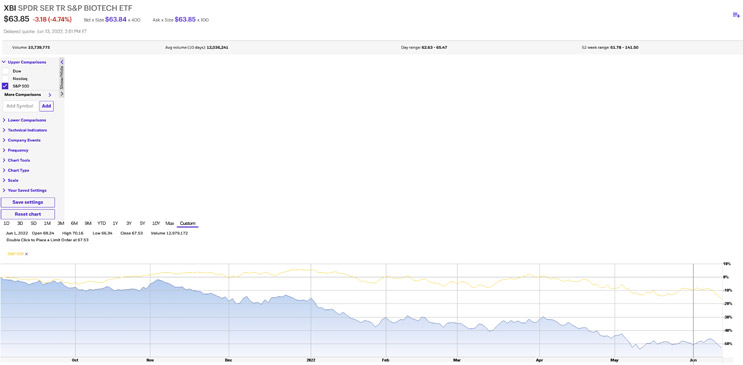Financial Market Tumult Shows The Need For Creative Funding For Life Sciences
By Winston Black, CEO, SWK Holdings

The Federal Reserve’s move to raise interest rates to battle inflation – now running at approximately 8% annually – has altered the risk and return for investors who are dealing with rising commodity prices and a pandemic that has altered consumption patterns. As interest rates increase, some investors are opting to curb risk in their portfolios, moving to short-term and inflation-indexed bonds. Market volatility sends risk-averse investors to the exits. “Junk bonds” – while rarely used among life sciences companies – could serve as a proxy for riskier borrowers as bond prices have fallen and yields have risen through much of 2022.
While life sciences companies are in a period of great innovation, they have not been immune to the upheaval in the financial markets, casting a pall over equity financing in the sector, as shown by a leading ETF being down more than 50% since September (See Chart 1 below). Research from Jefferies & Co. pointed out that 128 biotechs in early May are trading below their cash position, but take that figure with a few grains of salt or a few micrograms of the latest molecule under development. The cash is earmarked for clinical trials and needs to be viewed with how quickly it will be spent. That said, investor sentiment is clearly bearish toward much of the cash-burning life sciences sector.
Chart 1: The S&P Biotech ETF (XBI) fell more than 50% since early September through mid-June. During the same period, the S&P 500's decline was far less pronounced.
Biotechnology and other life sciences companies will need to be creative when it comes to raising capital. The cost of issuing equity for companies is much higher than it was in early 2021, posing a new challenge for executives and boards about how and where to invest or raise capital. While some IPOs are getting done, some have been packaged with warrants that can become dilutive to current equity holders and at valuations well below 2021’s peak. While not all life sciences companies are creditworthy, those that are should consider alternate financing solutions to preserve equity from being diluted.
Credit markets have had broader implications for life sciences companies seeking to borrow, regardless of where the borrower lands in the spectrum of credit quality. Higher-rated short-term debt yields have increased. For example, yields on one-month Treasury bills – which are considered the “risk-free rate” in many capital asset pricing models – have increased more than a full percentage point to 1.121% from 0.05% for the year-to-date period as of mid-June.1 High-yield triple C rated bonds – speculative, “junk” bonds with high credit risk – are yielding approximately 14.434%, near a 52-week high, compared with the 52-week low of 6.304%, according to high-yield bond data from ICE Data Services.2
So, with the broader financial markets serving as a backdrop, these are some of the outcomes that we anticipate in the life sciences finance market.
M&A: Big Pharma and large medtechs still have strong balance sheets to take advantage of opportunities to invest in their own pipelines or expand their pipelines from licensing or outright acquisitions. For example, Pfizer is paying $11.6 billion to acquire Biohaven Pharmaceutical Holding’s migraine medication business with its “existing cash on hand.” Despite rising rates, they are still low in historical terms and could make sense for deals that can generate returns over the cost of capital. While special purpose acquisition companies (SPACs) raised money easily in 2019 and 2020 and eagerly targeted biotechnology companies, some are facing deadlines to complete deals, or the SPAC sponsors have to refund the money they raised. Some may try to achieve deals before their respective deadlines.
Synthetic royalty agreements: These agreements can provide financing, but the life sciences company or patent holder is trading some of the upside of a product for immediate financing. The plus side of this arrangement is it does not dilute equity and often comes with fewer covenants than senior debt. It also offers creative financing options for “platform companies” that might have several product options derived from an existing technology. In this circumstance, the financing company and the life sciences company are married to the success of a product.
Convertible debt: Bonds that could be converted into equity could also present a creative financing solution. Key considerations of this approach are tied to the liquidity of the stock, the strike price for the conversion, and the terms between the borrower and lender. The coupon of these tend to be lower than secured debt, but the stock needs to have adequate trading volume to ensure that the bonds can be converted. The strike prices of these securities were traditionally at a 25% premium to the current share price, but issuers may have trepidation to issue a security that is tied to a depressed share price.
Covenants: Given 2021’s robust capital markets, some lenders have been fairly lax about their terms to compete in a competitive and low-interest rate market while having raised much capital to deploy. A few failures could affect lending within the life sciences sector. In the current market, one should expect lenders to want greater protections and deploy stronger underwriting to mitigate their risk exposure with greater controls around debt-to-equity ratios to guard against default.
Will There Be A Reckoning?
There is some reckoning now after a great deal of investment surged into the life sciences space to battle COVID-19 and fund promising new platform technologies. Raising money was fairly easy from venture capital firms, SPACs, private equity, IPOs, and strategic buyers looking at the life sciences sector. When a SPAC could offer a startup enough funding to skip a few rounds of fundraising, it shifted the dynamics in the sector.
An indicator about the state of the market should come in the second half of 2022 and early 2023. Many of the financings that closed in late 2021 and early 2022 were conceived during the go-go times of early 2021. Deals that were birthed during this period will need to navigate significantly altered capital markets, where shifts in interest rates, changing deal terms, and lowered equity valuations could make repayment and/or refinancing problematic.
For boards, management, and shareholders, there needs to be an understanding about the intrinsic value of the company compared with the share price or the valuation from a new round of investors. Importantly, decision-makers should not base valuation on 2021’s inflated metrics.
With rising interest rates and a lack of positive news flow, the market dynamic for financing life sciences companies is not where it was prior to COVID-19. It has become comparable to what it was like before the 2008 financial crisis. The struggle will be to continue funding innovation and figuring out which scientific developments will reach the market. That will never change, regardless of the financial market.
References
- https://www.wsj.com/market-data/bonds?mod=md_home_overview_bonds_main (accessed on June 13, 2022)
- https://www.wsj.com/market-data/bonds/benchmarks?mod=md_bond_view_tracking_bond_full
About The Author:
 Winston Black was appointed CEO of SWK Holdings Corp. in January 2016. He was then appointed to the Board of Directors in August 2019 and named Chairman in November 2019. Prior to joining SWK, he worked for PBS Capital Management, LLC, an investment management business investing in pharmaceutical royalties and healthcare equities, which Black co-founded in 2009. Prior to PBS Capital, he worked in a variety of finance roles centered in biotech and healthcare after receiving MBAs with distinction from both Columbia Business School and London Business School and receiving a BA in economics from Duke University, where he graduated cum laude.
Winston Black was appointed CEO of SWK Holdings Corp. in January 2016. He was then appointed to the Board of Directors in August 2019 and named Chairman in November 2019. Prior to joining SWK, he worked for PBS Capital Management, LLC, an investment management business investing in pharmaceutical royalties and healthcare equities, which Black co-founded in 2009. Prior to PBS Capital, he worked in a variety of finance roles centered in biotech and healthcare after receiving MBAs with distinction from both Columbia Business School and London Business School and receiving a BA in economics from Duke University, where he graduated cum laude.

